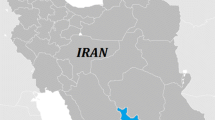Abstract
For the modelling of solar systems, reliable and complete time series of solar radiation are required. However, solar radiation data from ground measurements or satellite images may be available only for limited time periods and often have data quality issues or/and data gaps. It is possible to get reasonably accurate radiation estimates of solar radiation from meteorological parameters, which can complement or extend existing data. In this paper, a model based on eight meteorological parameters (evaporation, temperature, wind speed, visibility, cloud cover, sunshine duration, sunshine ratio and global solar radiation) is developed to predict the global solar radiation using 29-year (1986–2014) data from Oran radiometric station in Algeria. Two versions of the multiple regression analysis are used: the first with original observation variables (called as manifest variables) and the second by PCs called as latent variables or (common) factors. Separate analyses have been carried out for two scenarios: overall and partial study. The first scenario uses all climatic dataset, but the last scenario uses three subsets which are sunny, partly cloudy and cloudy days. This classification has been obtained using certain statistical properties that we have considered as thresholds. Stepwise multiple linear regression analysis is used to fit global solar radiation data using meteorological variables as predictors. A variable selection method based on PCA technique are used to obtain the subsets of predictors to be included in the regression model of global solar radiation data. Hence, the proposed relationships may be considered useful for predicting global solar radiation rate in other sites of Algeria that have climatic conditions similar to the study area.






Similar content being viewed by others
References
Almorox J (2011) Estimating global solar radiation from common meteorological data in Aranjuez, Spain. Turk J Phys 35(1):53–64
Angstrom A (1924) Solar and terrestrial radiation. report to the international commission for solar research on actinometric investigations of solar and atmospheric radiation. Q J R Meteorol Soc 50(210):121–126
Aoun N, Bouchouicha K (2017) Simple correlation models for estimation of horizontal global solar radiation for Oran, northwest Algeria. Int J Eng Res Afr Trans Tech Publ 32:124–132
Bakirci K (2015) Models for the estimation of diffuse solar radiation for typical cities in Turkey. Energy 82:827–838
Chegaar M, Chibani A (2001) Global solar radiation estimation in Algeria. Energy Convers Manag 42(8):967–973
Chegaar M, Guechi F (2009) Estimation of global solar radiation using meteorological parameters. Revue Int ’Heliotech 40:18–23
Chelbi M, Gagnon Y, Waewsak J (2015) Solar radiation mapping using sunshine duration-based models and interpolation techniques: application to Tunisia. Energy Convers Manag 101:203–215
De Souza JL, Lyra GB, Dos Santos CM, Junior RAF, Tiba C, Lyra GB, Lemes MAM (2016) Empirical models of daily and monthly global solar irradiation using sunshine duration for Alagoas state, northeastern Brazil. Sustain Energy Technol Assess 14:35–45
Duffie JA, Beckman WA (2013) Solar engineering of thermal processes. Wiley, Oxford
Li H, Ma W, Lian Y, Wang X, Zhao L (2011) Global solar radiation estimation with sunshine duration in Tibet, China. Renew Energy 36(11):3141–3145
Mecibah MS, Boukelia TE, Tahtah R, Gairaa K (2014) Introducing the best model for estimation the monthly mean daily global solar radiation on a horizontal surface (case study: Algeria). Renew Sustain Energy Rev 36:194–202
Medeiros FJd, Silva CM, Bezerra BG (2017) Calibration of ångström-prescott equation to estimate daily solar radiation on rio Grande do Norte state, Brazil. Rev Bras Meteorol 32(3):409–416
Nia M, Chegaar M, Benatallah M, Aillerie M (2013) Contribution to the quantification of solar radiation in Algeria. Energy Proced 36:730–737
Norton B (2013) Harnessing solar heat, vol 18. Springer, Berlin
Nwokolo SC, Ogbulezie JC (2017) A quantitative review and classification of empirical models for predicting global solar radiation in west Africa. Beni-Suef University Journal of Basic and Applied Sciences
Okundamiya MS, Emagbetere JO, Ogujor EA (2016) Evaluation of various global solar radiation models for Nigeria. Int J Green Energy 13(5):505–512
Prescott J (1940) Evaporation from a water surface in relation to solar radiation. Trans R Soc S Aust 46:114–118
Suehrcke H, Bowden RS, Hollands K (2013) Relationship between sunshine duration and solar radiation. Sol Energy 92:160–171
Swartman R, Ogunlade O (1967) Solar radiation estimates from common parameters. Sol Energy 11(3–4):170–172
Trabea A, Shaltout MM (2000) Correlation of global solar radiation with meteorological parameters over Egypt. Renew Energy 21(2):297–308
Weisberg S (2005) Applied linear regression, vol 528. Wiley, New York
Acknowledgements
Special thanks go to Prof. Harry SUEHRCKE and Prof. Ross BOWDEN of James Cook University of Australia for their valuable support during the research.
Author information
Authors and Affiliations
Corresponding author
Additional information
Responsible Editor: M. Telisman Prtenjak.
Publisher's Note
Springer Nature remains neutral with regard to jurisdictional claims in published maps and institutional affiliations.
Rights and permissions
About this article
Cite this article
Abdelhafidi, N., Bachari, N.E.I. & Abdelhafidi, Z. Estimation of solar radiation using stepwise multiple linear regression with principal component analysis in Algeria. Meteorol Atmos Phys 133, 205–216 (2021). https://doi.org/10.1007/s00703-020-00739-0
Received:
Accepted:
Published:
Issue Date:
DOI: https://doi.org/10.1007/s00703-020-00739-0




